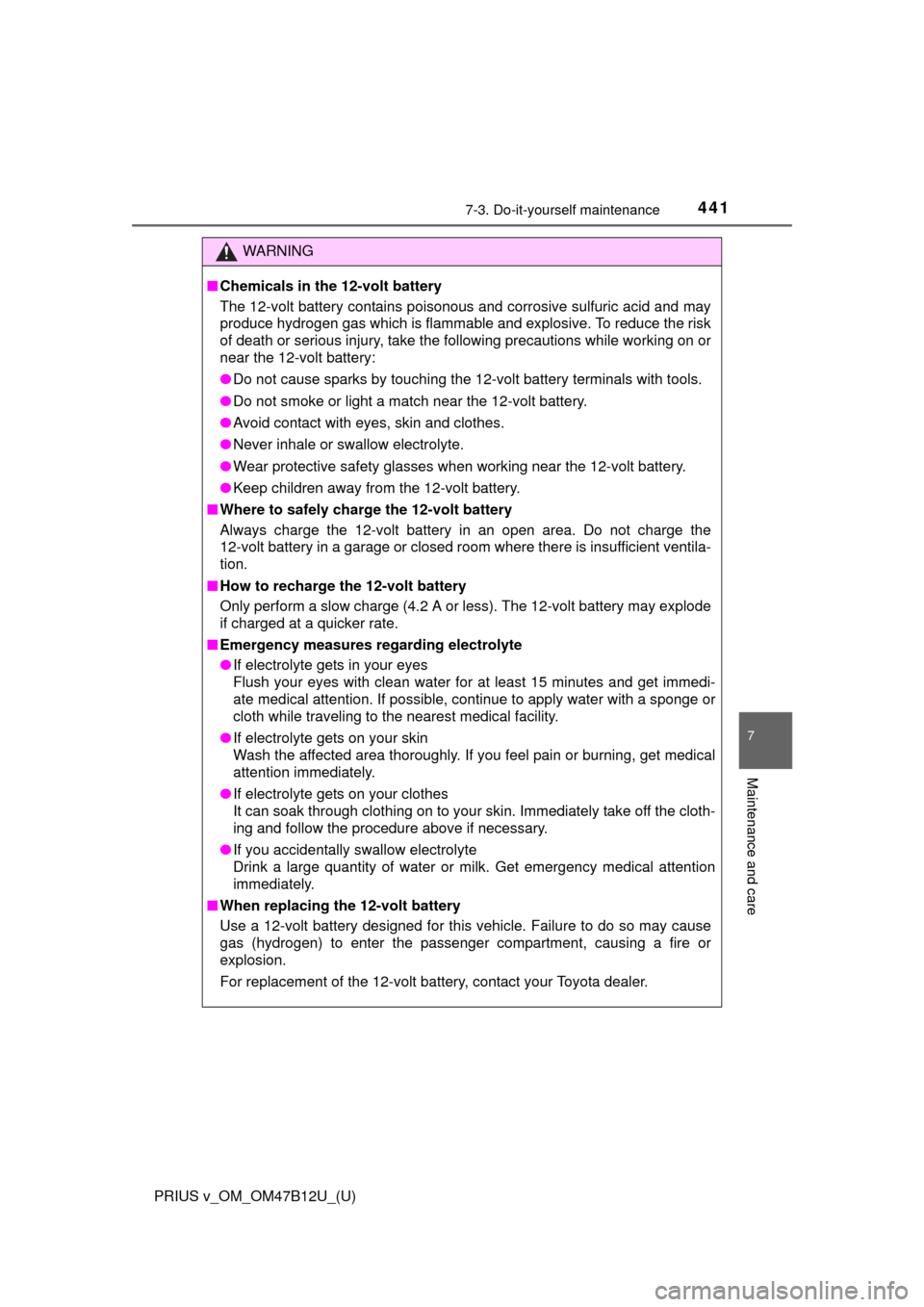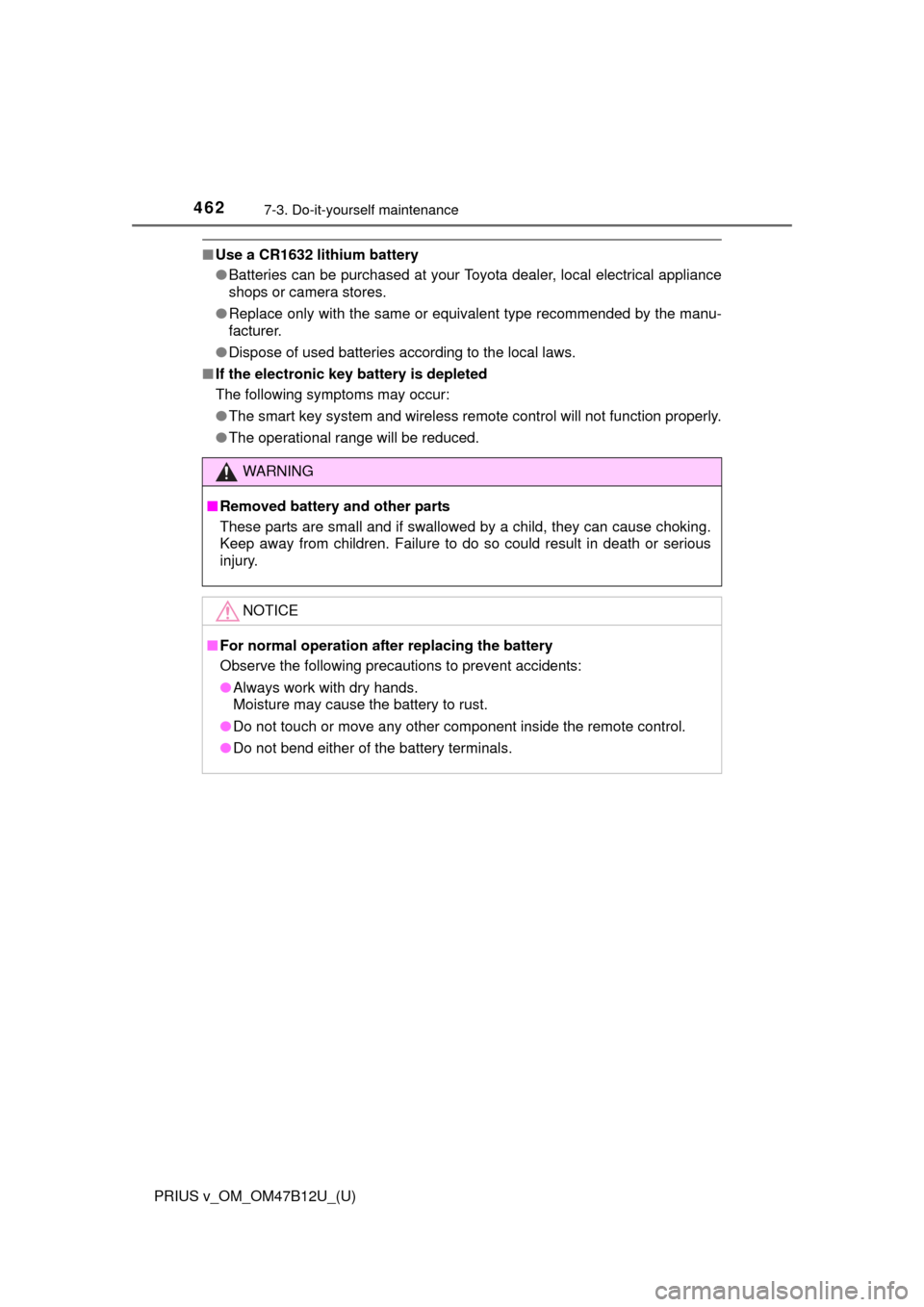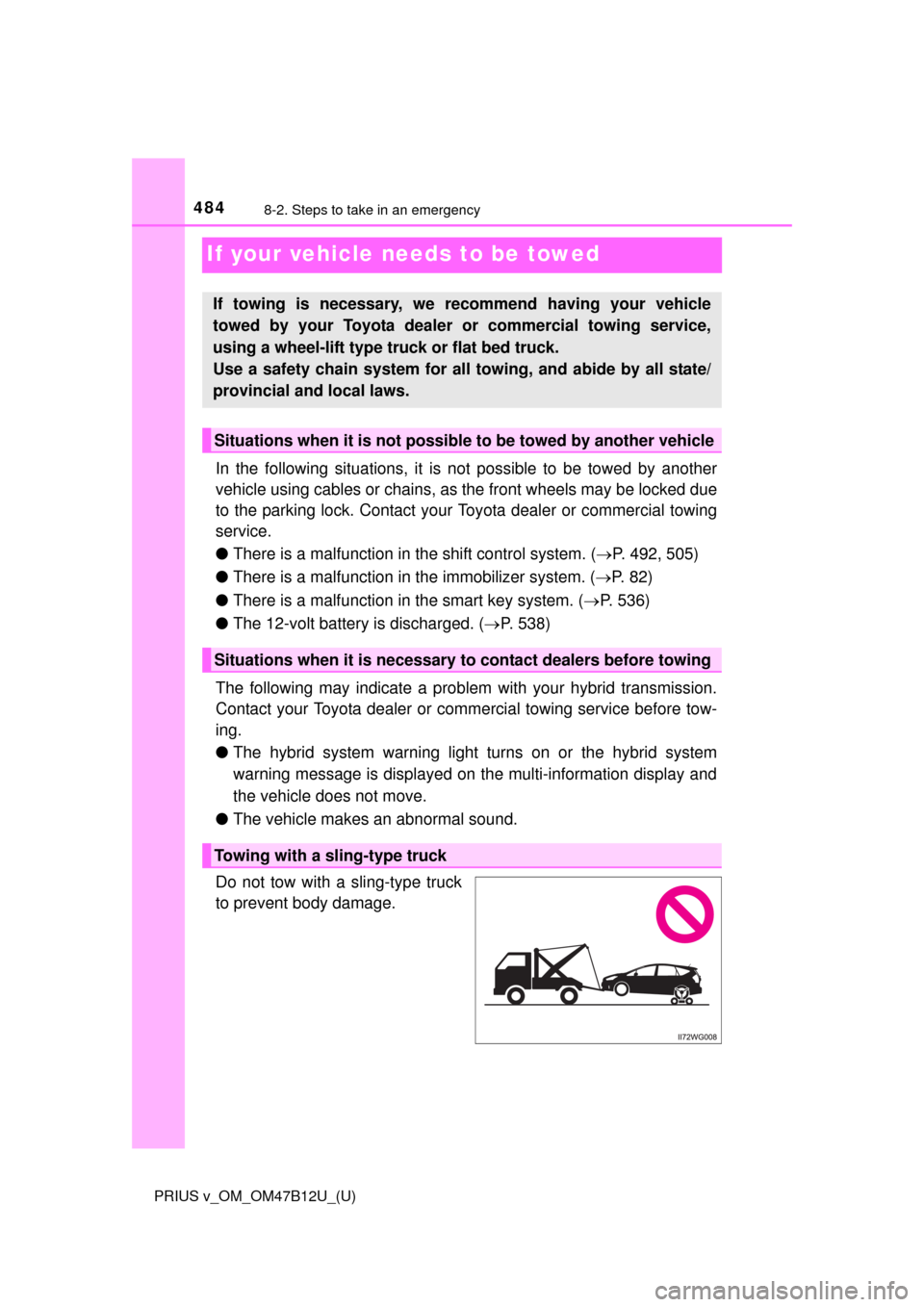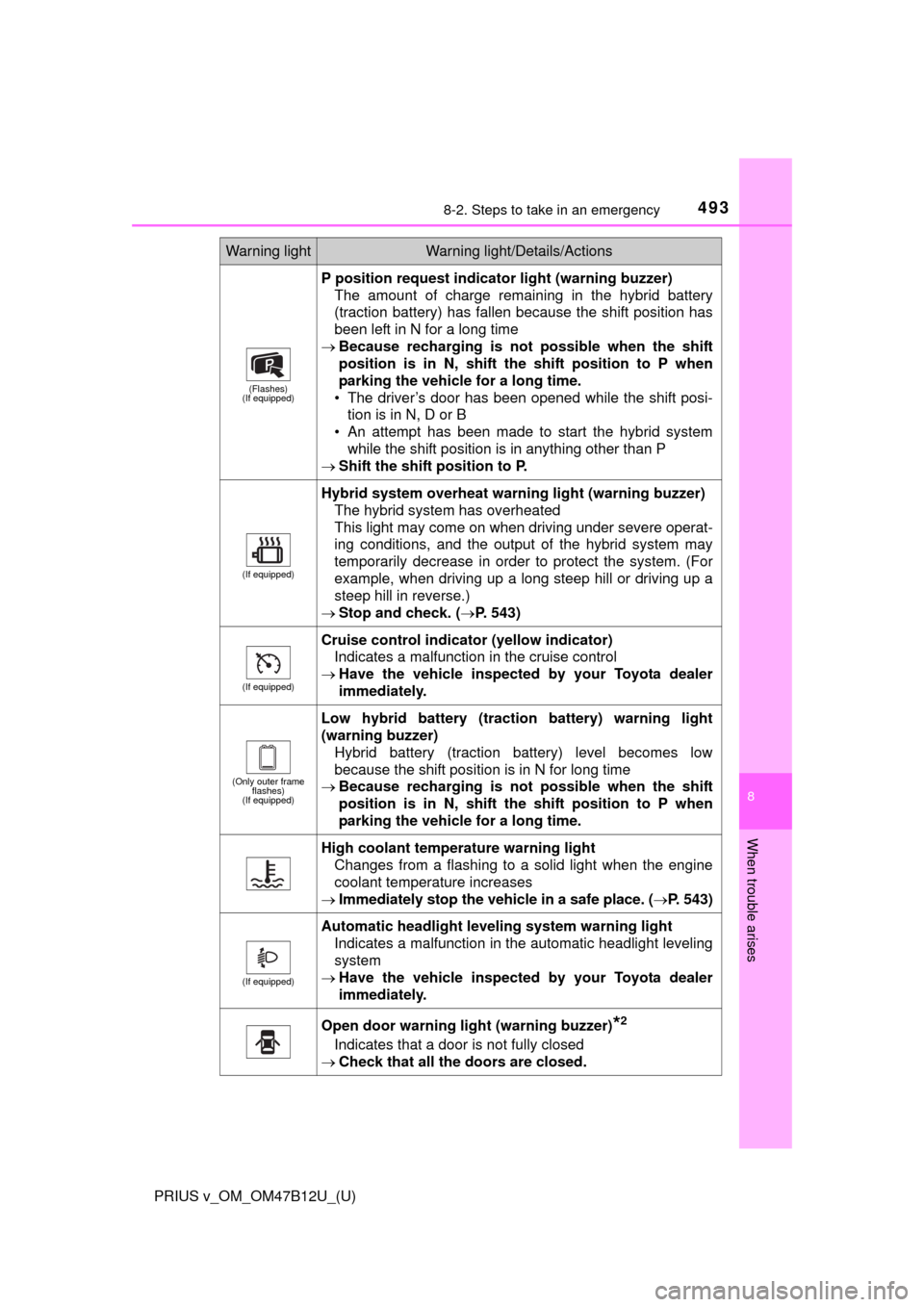Page 441 of 620

PRIUS v_OM_OM47B12U_(U)
4417-3. Do-it-yourself maintenance
7
Maintenance and care
WARNING
■Chemicals in the 12-volt battery
The 12-volt battery contains poisonous and corrosive sulfuric acid and may
produce hydrogen gas which is flammable and explosive. To reduce the risk
of death or serious injury, take the following precautions while working on or
near the 12-volt battery:
●Do not cause sparks by touching the 12-volt battery terminals with tools.
●Do not smoke or light a match near the 12-volt battery.
●Avoid contact with eyes, skin and clothes.
●Never inhale or swallow electrolyte.
●Wear protective safety glasses when working near the 12-volt battery.
●Keep children away from the 12-volt battery.
■Where to safely charge the 12-volt battery
Always charge the 12-volt battery in an open area. Do not charge the
12-volt battery in a garage or closed room where there is insufficient ventila-
tion.
■How to recharge the 12-volt battery
Only perform a slow charge (4.2 A or less). The 12-volt battery may explode
if charged at a quicker rate.
■Emergency measures regarding electrolyte
●If electrolyte gets in your eyes
Flush your eyes with clean water for at least 15 minutes and get immedi-
ate medical attention. If possible, continue to apply water with a sponge or
cloth while traveling to the nearest medical facility.
●If electrolyte gets on your skin
Wash the affected area thoroughly. If you feel pain or burning, get medical
attention immediately.
●If electrolyte gets on your clothes
It can soak through clothing on to your skin. Immediately take off the cloth-
ing and follow the procedure above if necessary.
●If you accidentally swallow electrolyte
Drink a large quantity of water or milk. Get emergency medical attention
immediately.
■When replacing the 12-volt battery
Use a 12-volt battery designed for this vehicle. Failure to do so may cause
gas (hydrogen) to enter the passenger compartment, causing a fire or
explosion.
For replacement of the 12-volt battery, contact your Toyota dealer.
Page 442 of 620
442
PRIUS v_OM_OM47B12U_(U)
7-3. Do-it-yourself maintenance
WARNING
■When disconnecting the 12-volt battery
NOTICE
■When recharging the 12-volt battery
Never recharge the 12-volt battery while the hybrid system is operating.
Also, be sure all accessories are turned off.
Do not disconnect the negative (-) termi-
nal on the body side as shown. The dis-
connected negative (-) terminal may
touch the positive (+) terminal, which
may cause a short and result in death or
serious injury.
Page 461 of 620
461
PRIUS v_OM_OM47B12U_(U)
7-3. Do-it-yourself maintenance
7
Maintenance and care
Electronic key batter y
●Flathead screwdriver
●Lithium battery CR1632
Take out the mechanical key.
Remove the cover.
To prevent damage to the key,
cover the tip of the screwdriver with
a rag.
Remove the depleted battery.
Insert a new battery with the “+”
terminal facing up.
When installing, reverse the steps listed.
Replace the battery with a new one if it is depleted.
You will need the following items:
Replacing the battery
1
2
ITO43P194
3
4
Page 462 of 620

462
PRIUS v_OM_OM47B12U_(U)
7-3. Do-it-yourself maintenance
■Use a CR1632 lithium battery
●Batteries can be purchased at your Toyota dealer, local electrical appliance
shops or camera stores.
●Replace only with the same or equivalent type recommended by the manu-
facturer.
●Dispose of used batteries according to the local laws.
■If the electronic key battery is depleted
The following symptoms may occur:
●The smart key system and wireless remote control will not function properly.
●The operational range will be reduced.
WARNING
■Removed battery and other parts
These parts are small and if swallowed by a child, they can cause choking.
Keep away from children. Failure to do so could result in death or serious
injury.
NOTICE
■For normal operation after replacing the battery
Observe the following precautions to prevent accidents:
●Always work with dry hands.
Moisture may cause the battery to rust.
●Do not touch or move any other component inside the remote control.
●Do not bend either of the battery terminals.
Page 481 of 620
481
PRIUS v_OM_OM47B12U_(U)
8When trouble arises
8-1. Essential information
Emergency flashers .......... 482
If your vehicle has to
be stopped in an
emergency ...................... 483
8-2. Steps to take in an
emergency
If your vehicle needs to
be towed ......................... 484
If you think something is
wrong .............................. 489
If a warning light turns on
or a warning buzzer
sounds ............................ 490
If a warning message is
displayed......................... 503
If you have a flat tire.......... 521
If the hybrid system will
not start ........................... 534
If the electronic key does
not operate properly........ 536
If the 12-volt battery is
discharged ...................... 538
If your vehicle overheats ... 543
If the vehicle becomes
stuck ............................... 548
Page 484 of 620

484
PRIUS v_OM_OM47B12U_(U)
8-2. Steps to take in an emergency
If your vehicle needs to be towed
In the following situations, it is not possible to be towed by another
vehicle using cables or chains, as the front wheels may be locked due
to the parking lock. Contact your Toyota dealer or commercial towing
service.
●There is a malfunction in the shift control system. (P. 492, 505)
●There is a malfunction in the immobilizer system. (P. 82)
●There is a malfunction in the smart key system. (P. 536)
●The 12-volt battery is discharged. (P. 538)
The following may indicate a problem with your hybrid transmission.
Contact your Toyota dealer or commercial towing service before tow-
ing.
●The hybrid system warning light turns on or the hybrid system
warning message is displayed on the multi-information display and
the vehicle does not move.
●The vehicle makes an abnormal sound.
Do not tow with a sling-type truck
to prevent body damage.
If towing is necessary, we recommend having your vehicle
towed by your Toyota dealer or commercial towing service,
using a wheel-lift type truck or flat bed truck.
Use a safety chain system for all towing, and abide by all state/
provincial and local laws.
Situations when it is not possible to be towed by another vehicle
Situations when it is necessary to contact dealers before towing
Towing with a sling-type truck
Page 493 of 620

4938-2. Steps to take in an emergency
PRIUS v_OM_OM47B12U_(U)
8
When trouble arises
(Flashes)
(If equipped)
P position request indicator light (warning buzzer)
The amount of charge remaining in the hybrid battery
(traction battery) has fallen because the shift position has
been left in N for a long time
Because recharging is not possible when the shift
position is in N, shift the shift position to P when
parking the vehicle for a long time.
• The driver’s door has been opened while the shift posi-
tion is in N, D or B
• An attempt has been made to start the hybrid system
while the shift position is in anything other than P
Shift the shift position to P.
(If equipped)
Hybrid system overheat warning light (warning buzzer)
The hybrid system has overheated
This light may come on when driving under severe operat-
ing conditions, and the output of the hybrid system may
temporarily decrease in order to protect the system. (For
example, when driving up a long steep hill or driving up a
steep hill in reverse.)
Stop and check. (P. 543)
(If equipped)
Cruise control indicator (yellow indicator)
Indicates a malfunction in the cruise control
Have the vehicle inspected by your Toyota dealer
immediately.
(Only outer frame
flashes)
(If equipped)
Low hybrid battery (traction battery) warning light
(warning buzzer)
Hybrid battery (traction battery) level becomes low
because the shift position is in N for long time
Because recharging is not possible when the shift
position is in N, shift the shift position to P when
parking the vehicle for a long time.
High coolant temperature warning light
Changes from a flashing to a solid light when the engine
coolant temperature increases
Immediately stop the vehicle in a safe place. (P. 543)
(If equipped)
Automatic headlight leveling system warning light
Indicates a malfunction in the automatic headlight leveling
system
Have the vehicle inspected by your Toyota dealer
immediately.
Open door warning light (warning buzzer)*2
Indicates that a door is not fully closed
Check that all the doors are closed.
Warning lightWarning light/Details/Actions
Page 496 of 620

4968-2. Steps to take in an emergency
PRIUS v_OM_OM47B12U_(U)
■SRS warning light
This warning light system monitors the airbag sensor assembly, front impact
sensors, side impact sensors (front), side impact sensors (front door), side
impact sensors (rear), driver’s seat position sensor, driver’s seat belt buckle
switch, front passenger occupant classification system (ECU and sensors),
“AIR BAG ON” indicator light, “AIR BAG OFF” indicator light, front passen-
ger’s seat belt buckle switch, seat belt pretensioner assemblies, airbags,
interconnecting wiring and power sources. (P. 41)
■Front passenger detection sensor, seat belt reminder and warning
buzzer
●If luggage is placed on the front passenger seat, the front passenger detec-
tion sensor may cause the warning light to flash and the warning buzzer to
sound even if a passenger is not sitting in the seat.
●If a cushion is placed on the seat, the sensor may not detect a passenger,
and the warning light may not operate properly.
■Electric power steering system warning light (warning buzzer)
When the 12-volt battery charge becomes insufficient of the voltage tempo-
rarily drops, the electric power steering system warning light may come on
and the warning buzzer may sound.
■If the malfunction indicator lamp comes on while driving
First check the following:
●Is the fuel tank empty?
If it is, fill the fuel tank immediately.
●Is the fuel tank cap loose?
If it is, tighten it securely.
The malfunction indicator lamp will go off after several driving trips.
If the malfunction indicator lamp does not go off even after several trips, con-
tact your Toyota dealer as soon as possible.